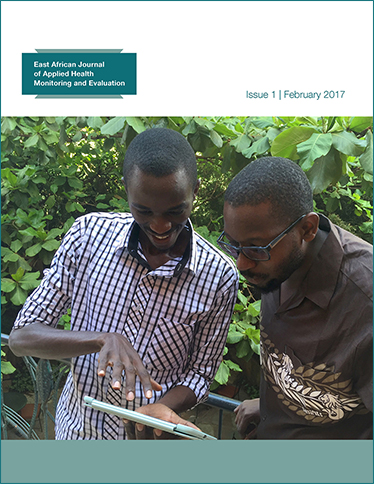A new academic journal born from a UCSF Global Health Sciences partnership with Tanzania’s Mzumbe University is the first of its kind in East Africa, and one of the only journals worldwide dedicated to health monitoring and evaluation (M&E).
 The online East African Journal of Applied Health Monitoring and Evaluation (EAJAHME) provides a forum for M&E research that has not fit in traditional public health journals. Health monitoring and evaluation is a growing field that focuses on using data collected in local, regional and country-level health systems to strengthen the quality of those systems and improve patient outcomes.
The online East African Journal of Applied Health Monitoring and Evaluation (EAJAHME) provides a forum for M&E research that has not fit in traditional public health journals. Health monitoring and evaluation is a growing field that focuses on using data collected in local, regional and country-level health systems to strengthen the quality of those systems and improve patient outcomes.
UCSF Global Health Sciences’ Global Strategic Information (GSI) group has worked on several M&E initiatives in Tanzania since signing a 2008 cooperative agreement with the Ministry of Health, Community Development, Gender, Elderly and Children (MOHCDGEC) to provide technical assistance and capacity building. With UCSF’s help, Mzumbe University launched the region’s first Center of Excellence in Health Monitoring and Evaluation and developed a unique Master of Science in Health Monitoring and Evaluation program. Christen Said, GSI’s in-country program manager, was pivotal to creating the associated journal.
One goal of the new journal is to raise the profile of the master’s program and Center of Excellence and establish them as go-to sites for M&E training and resources in East Africa. Although Mzumbe University has generated valuable health-related data, until now “students and faculty didn’t have a way to get their research out,” says GSI’s Susie Welty, one of the journal’s editorial assistants. “We wanted M&E publications to have a home.”
Starting a journal from scratch was challenging, but chief editor Debbie Bain Brickley, GSI’s deputy director of training and education, is helping the EAJAHME adhere to high standards. The journal follows best practices in publishing, including a rigorous, double-blind peer review process in which each article has at least two reviewers—one from Mzumbe and one from UCSF or another institution. The journal plans to publish articles on a rolling basis and package them into an annual issue, all freely available online.
Although UCSF faculty and staff currently comprise EAJAHME’s editorial board, their objective is for Mzumbe University eventually to take over editing and coordinating the journal. GSI has held several writing workshops in Tanzania to increase the number of local scholars who are able to get their research published, and expects that researchers, public health practitioners, and institutions from throughout the region will contribute to the journal.
“We’re looking for original, high-quality articles focusing on applied experiences of M&E in the health sector in Africa, with a particular focus on East Africa,” says Dr. Brickley. The editorial board was pleased to receive excellent manuscripts for the inaugural issue, she said, including an article about the effectiveness of triangulating data to better understand the HIV epidemic and improve HIV services, and another about the impact of a microfinance program on women’s access to health care, housing and sanitation.
The ultimate goal of the EAJAHME is to create and disseminate a body of knowledge of health-related M&E and encourage discussion about M&E best practices, say the journal’s creators. Sharing M&E data is essential to guiding public health decisions, and countries in East Africa have much to learn from each other’s experiences. The East African Journal of Applied Health Monitoring and Evaluation aims to build a new M&E community that benefits Tanzania, East Africa and beyond.